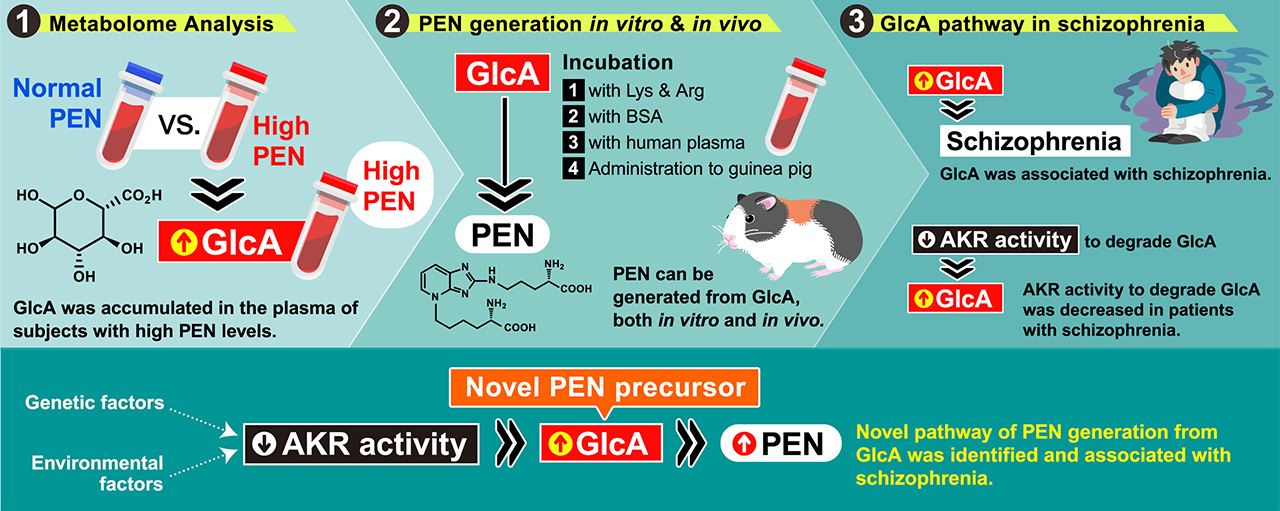Meet our scientists!
 Back
Back
Schizophrenia is a mental disorder characterized by recurrent psychoses and alterations in perception, thoughts, and behaviors. While schizophrenia can be treated with antipsychotic medications, its causes are still relatively unknown. Kazuya Toriumi of the Schizophrenia Research Project is interested in identifying the molecular pathways involved in the development of schizophrenia. Previously studies from the Schizophrenia Research Project had shown that advanced glycation end products (AGEs), deleterious products formed by oxidative and carbonyl stresses, are found at high levels in a large subset of patients with schizophrenia. In particular, pentosidine, an AGE consisting of a crosslink between arginine and lysine residues in proteins, is found in high amounts in many patients with schizophrenia. Dr. Toriumi wanted to understand why pentosidine amounts increase in these patients with schizophrenia and identified glucuronic acid as a pentosidine precursor. This work will be helpful in developing more accurate animal and cell models of schizophrenia and may have positive implications in the development of novel therapies. It was published in Redox Biology in an article entitled, “Glucuronic acid is a novel source of pentosidine associated with schizophrenia.” We spoke to him about his work and interest in science.

How did you first become interested in research and schizophrenia?
I originally wanted to become a high school teacher, but when I pursued undergraduate research in college, I realized that I really enjoy research. Almost 1% of people are diagnosed with schizophrenia during their lifetime. My primary interest is in understanding what causes schizophrenia and helping these people. Furthermore, I am also interested in understanding how the brain works. In particular, I want to know how we sense and understand the world around us, and schizophrenia involves an alteration in the way we understand the world, so, if we can figure out what changes in schizophrenia, we will also gain an understanding of what happens in a “normal” brain.
Why did you focus on pentosidine?
Pentosidine is an advanced glycation end product or AGE, where a sugar is covalently attached to a protein. Previously, we found that high amounts of pentosidine are found in a subset of patients with schizophrenia, and we think that high pentosidine might be a cause of some types of schizophrenia. So, I wanted to know why pentosidine increases in some people. It’s commonly thought that high amounts of sugar cause increases in pentosidine and other AGEs, but when we looked at patients with schizophrenia with high pentosidine, we didn’t see high levels of sugars or hemoglobin A1c, which is an indicator of excess sugar in the bloodstream. This led me to hypothesize that there must be a different pathway responsible for high pentosidine. If I could find this pathway, it would help us understand what causes some types of schizophrenia. It would also allow us to make more accurate cell and animal models of schizophrenia.
How did you identify glucuronic acid as a precursor for pentosidine?
We did metabolome analyses on patients with schizophrenia with high pentosidine and healthy controls and looked for differences in metabolites. We found that in patients with high pentosidine, there was a high amount of glucuronic acid. Pentosidine consists of a sugar bridge between lysine and arginine amino acids, so we next mixed lysine, arginine, and glucuronic acid, and we found that pentosidine is produced over time. Mixing glucuronic acid with proteins or plasma also produced pentosidine. Finally, we showed that injecting glucuronic acid into guinea pigs caused pentosidine to increase. When we looked at the correlation between high pentosidine and schizophrenia, we found that an increase of pentosidine by one standard deviation roughly doubles the chances that a person has schizophrenia. An enzyme, aldo-keto reductase or AKR breaks down glucuronic acid and we found that AKR enzymatic activity is reduced in patients with schizophrenia. So, we think that reduced AKR increases glucuronic acid, which increases pentosidine, and increases the chances of someone becoming schizophrenic.
Fascinating! What are your plans for the future?
We’re planning to use this information to make more accurate cell and animal models of schizophrenia. For example, we can knock out AKR in animals and determine whether these animals display schizophrenia-like phenotypes. I don’t think increasing glucuronic acid on its own is sufficient to cause schizophrenia, but I think it could be an important step. In addition, we are excited to be pursuing large-scale cohort studies with Dr. Nishida at the institute. In these studies, we start with large cohorts of Tokyo residents starting at 10 years of age and examine them every two years. Some of the people in these studies will develop schizophrenia or other neurological diseases as they age. By looking at cohort data, we will be able to determine whether high amounts of AGEs or pentosidine at early ages are associated with development of schizophrenia at later ages.

Overview of our findings.
Abbreviations: Pentosidine (PEN), glucuronic acid (GlcA), bovine serum albumin (BSA), aldo-keto reductase (AKR).Interviewed by Jun Horiuch